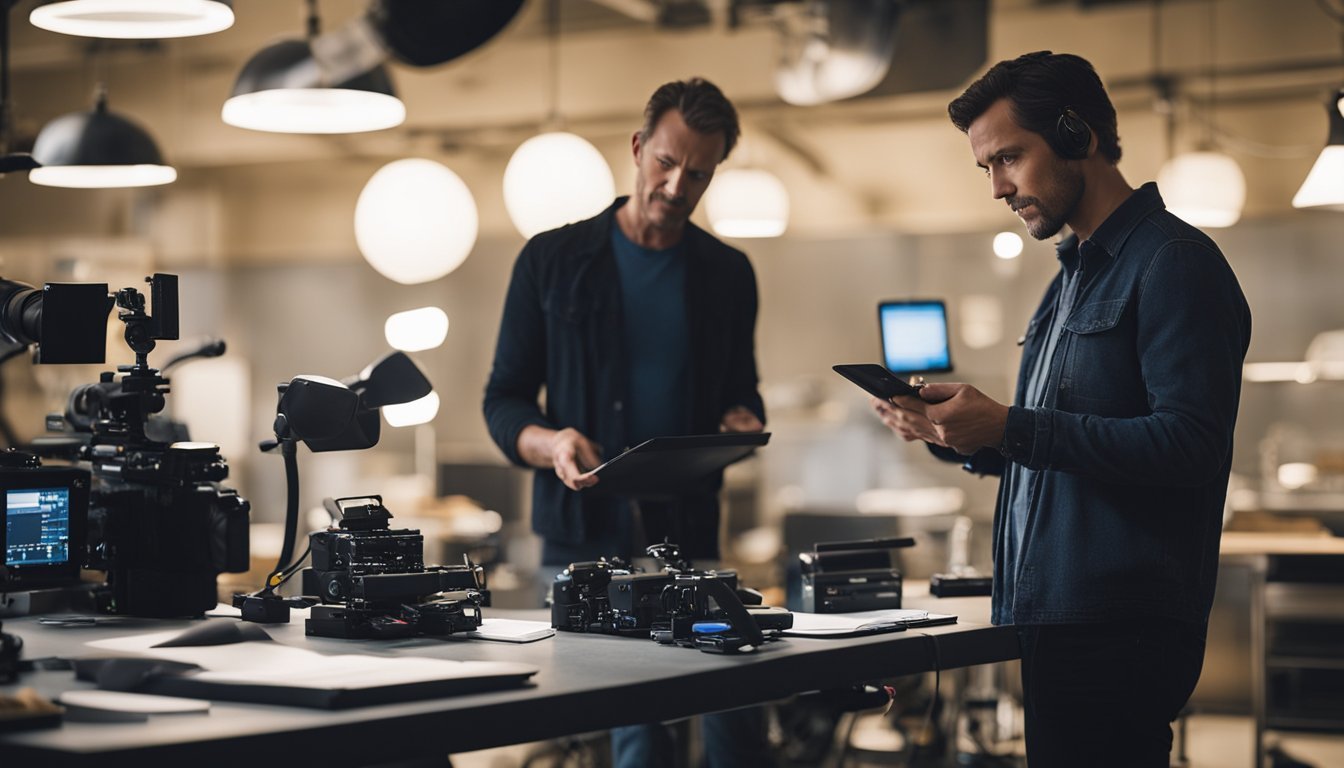The role of the script supervisor
Key to On-set Continuity and Consistency
A script supervisor plays a crucial role in film production by ensuring continuity and consistency throughout the shoot. Often referred to as the unsung heroes of the set, they meticulously log every detail from shot to shot, making sure that everything aligns perfectly in the final edit. This can include keeping track of actor movements, dialogue, and even the smallest props.
Sitting beside the director, script supervisors act as the director's right-hand, maintaining the script's integrity from pre-production through post-production. Their keen attention to detail helps prevent continuity errors that could disrupt the visual narrative, ensuring a seamless viewing experience for the audience.
Script supervisors also bridge communication among the production team. By providing thorough notes and reports, they assist various departments in maintaining a cohesive and accurate portrayal of each scene. This vital role ensures that the director’s vision is executed flawlessly, making them an indispensable asset to any film production.
Overview of the Script Supervisor Role
A script supervisor, commonly referred to as a continuity supervisor, is essential in maintaining the visual consistency of a film. Their primary responsibility is to ensure that the narrative's continuity is preserved throughout the filming process.
These professionals work closely with the director and other department heads. Script supervisors meticulously track details such as wardrobe, props, set dressing, hair, makeup, and actor movements.
During filming, they take detailed notes and log technical information. This data helps maintain coherence in the final cut of the film, avoiding potential continuity errors.
They also act as a bridge between the director and the editor. Their notes and observations are crucial during the editing phase, making sure every scene aligns correctly.
Below is a brief list of their key tasks:
Tracking script changes
Noting actor positions and movements
Recording timing of shots
Ensuring consistency in costumes and props
A skilled script supervisor adds significant value by preventing reshoots and maintaining seamless continuity across scenes.
Pre-Production Responsibilities
In pre-production, the script supervisor ensures the film's foundation is solid by performing detailed script analysis, maintaining continuity logs, and coordinating technical rehearsals.
Script Breakdown and Analysis
The script supervisor begins by scrutinizing the script in depth. This involves identifying each scene’s elements, such as character movements, props, and costumes. They mark any potential continuity issues, ensuring all departments are aware of scene-specific requirements. This careful preparation helps avoid mistakes during shooting.
Key tasks include:
Identifying key elements for every scene.
Noting potential continuity challenges.
Collaborating with department heads to align on scene requirements.
Creating the Continuity Log
Creating the continuity log is another essential task. The log is an extensive record that tracks intricate details such as character appearances, actions, and dialogues. This documentation is vital for maintaining consistency across takes and scenes. Each item is meticulously noted to ensure nothing disrupts the film’s visual narrative.
Contents typically include:
Character movements and positions.
Dialogue specifics for each scene.
Props and costumes usage.
Technical Rehearsals Coordination
The script supervisor also plays a key role in coordinating technical rehearsals. They work closely with the director and other technical crew members to ensure that every aspect of the scene is rehearsed comprehensively. During these rehearsals, the supervisor monitors for potential continuity errors and addresses them beforehand.
Responsibilities include:
Coordinating with technical crew for rehearsals.
Identifying continuity issues during practice runs.
Ensuring scenes are performed consistently across takes.
On-Set Duties
Script supervisors have a range of on-set duties that are integral to maintaining the seamless flow of film production. They ensure that every detail is consistent and in line with the script, from actors' performances to the coordination with various departments.
Maintaining Script Continuity
Script continuity involves ensuring that all elements within a scene remain consistent from shot to shot. This includes props, costumes, and other set details. A script supervisor documents every action, dialogue, and movement meticulously. They often refer to their notes to verify specifics, such as which hand an actor uses to hold an object. By doing so, they help prevent continuity errors that could disrupt the visual flow of a film.
Monitoring the Actors' Performances
Monitoring actors' performances is another critical task. The script supervisor tracks all the details of an actor’s actions and expressions during different takes. This includes their positioning, timing, and delivery of lines. They must ensure that these elements match the script precisely. Any discrepancies are reported to the director to maintain consistency. This attention to detail is crucial, as even minor differences can affect the narrative continuity.
Liaising with the Director and Department Heads
Close collaboration with the director and department heads is essential. The script supervisor communicates any continuity issues or discrepancies that arise during filming. They work with departments such as props, costumes, and set design to ensure that all visual elements are consistent. This coordination helps in resolving potential issues swiftly, ensuring that the director's vision is accurately translated onto the screen.
Timekeeping and Notes for the Editor
Timekeeping and providing detailed notes for the editor forms another vital aspect of the script supervisor’s role. They log the duration of each shot and scene, documenting every take comprehensively. These notes include information about the slate, takes, and any technical issues. Such detailed records are invaluable during the editing process, helping editors to piece together scenes smoothly. The script supervisor’s meticulous documentation aids in creating a coherent final cut.
Continuity in Visual Storytelling
Continuity in visual storytelling is vital to maintaining the seamless flow of a narrative. Through meticulous attention to detail, script supervisors ensure that props, costumes, and cinematographic elements remain consistent throughout production.
Prop and Set Continuity
Prop and set continuity involves monitoring and tracking all objects within a scene. Script supervisors ensure props are placed consistently in every shot. They document where each item is located and how it is used. This includes verifying the position and condition of objects down to minor details.
Set continuity also extends to the arrangement of furniture and set dressing. The goal is to create an unbroken visual experience, avoiding any noticeable discrepancies that could distract the audience.
Costume and Makeup Continuity
Costume and makeup continuity guarantee that characters' appearances remain consistent from scene to scene. Script supervisors work closely with costume designers and makeup artists. They make detailed notes covering every aspect, including clothing, accessories, and hairstyles.
For instance, if an actor has a tear in their shirt in one take, it must be present in the following takes. Makeup must match precisely, including any wounds or scars.
Cinematography Continuity
Cinematography continuity ensures the visual quality and style remain uniform. This covers maintaining consistent lighting, camera angles, and movement across different shots. Script supervisors liaise with cinematographers to check that lighting rigs and camera settings are identical in every take.
Careful attention is given to factors such as shadows' direction and intensity. Consistency in these elements is crucial to maintain the narrative's visual integrity and avoid disruptions in the storytelling flow.
Post-Production Support
Script supervisors play a pivotal role in post-production, ensuring that all footage aligns perfectly with the script and maintaining seamless continuity. Their involvement is crucial for delivering a polished final product.
Reviewing Daily Footage
Script supervisors meticulously review daily footage, often referred to as "dailies" or "rushes." This process involves comparing filmed scenes against the script notes taken during production. They identify any discrepancies or errors from the previous day's shoot, flagging inconsistencies that need correction.
Ensuring that all visual and audio elements align, they collaborate with editors to correct any issues. This thorough review helps avoid potential mistakes in the final cut, enabling a smoother editing process.
Updating the Continuity Log
Maintaining an up-to-date continuity log is essential. The log contains critical details such as actors’ positions, wardrobe, props, and other visual elements. Script supervisors ensure that every change or adjustment is accurately recorded.
These notes are indispensable for the editing team to understand the sequence of events and maintain scene integrity. A well-maintained continuity log contributes significantly to the overall coherence of the film, ensuring a seamless viewer experience.
Assisting with Reshoots
When reshoots are necessary, the script supervisor’s detailed records become invaluable. They provide precise information about previous takes to match lighting, camera angles, actors' positions, and even specific dialogue delivery.
Their expertise ensures that new footage seamlessly integrates with existing material, maintaining continuity. Script supervisors work closely with directors and cinematographers during reshoots, guiding them to achieve the required consistency. This collaboration is vital for maintaining the film’s overall narrative flow and visual continuity.
Tools and Technology for the Script Supervisor
Script supervisors rely on a mix of traditional tools and modern technology to ensure seamless continuity on set.
Traditional Tools
Script Binder: A critical accessory, containing annotated scripts and detailed notes.
Continuity Sheets & Logs: Documents where scene details, character actions, and shot information are meticulously recorded.
Stopwatch: Essential for timing scenes and maintaining pace.
Technology
Continuity Software: Digital tools like MovieSlate, ScriptE, and Shotgun assist with logging and managing continuity data.
Tablets & Apps: Tablets loaded with specialized apps allow script supervisors to update continuity notes on the go.
Digital Cameras: Used for taking reference photos of sets, props, and wardrobe to ensure visual consistency.
Audio Recording Devices
These devices capture dialogue details and audio notes, assisting with accurate scene replication and reshoots.
Video Assist and Monitors
Real-time monitoring helps script supervisors closely track takes and spot continuity issues during shooting.
Laptop Computers
For organizing digital documents, accessing software, and updating notes, laptops are indispensable.
Cloud Storage
Services like Google Drive and Dropbox enable script supervisors to store and share documents efficiently with the production team.
Walkie-Talkies
Facilitate instant communication with crew members, aiding in quick troubleshooting and coordination.
Employing a mix of these tools ensures that script supervisors can maintain the high level of detail required to keep a film's narrative consistent and cohesive.
Challenges and Problem-Solving Strategies
Script supervisors face numerous challenges on set, from handling discrepancies and inconsistencies to managing last-minute changes and dealing with environmental variables. Each of these obstacles requires specific strategies to maintain continuity and consistency in film production.
Handling Discrepancies and Inconsistencies
Discrepancies and inconsistencies are common on set. Script supervisors must frequently compare the current shooting script to what is being filmed.
They need to note every minute detail, like prop placement, actor positions, and costume changes. Recording these elements with precision helps ensure that each take aligns perfectly with the last.
When discrepancies arise, it is vital to address them immediately. The supervisor must communicate with the director and department heads to correct any issues. This may involve reviewing footage or discussing adjustments.
Maintaining a detailed logbook or digital database aids in quick reference and helps prevent errors from reoccurring.
Managing Changes on the Fly
Film sets are dynamic environments. Last-minute changes to scripts or scenes are common, and script supervisors must adapt quickly.
They must track any changes in real-time and update the shooting script accordingly. This includes documenting any improvised lines or altered actions.
Effective communication is critical. The supervisor needs to relay these alterations to all relevant departments to ensure everyone is on the same page.
Using tools like annotated scripts or digital tablets can streamline this process. Quick adaptability and sharp attention to detail are essential skills for managing these changes effectively.
Dealing with Environmental Variables
Environmental factors such as weather, lighting, and ambient noise can significantly affect continuity.
Weather changes can disrupt outdoor scenes. The script supervisor must note any shifts in lighting or weather between takes. This information helps filmmakers recreate consistent scenes when shooting resumes.
Lighting variations in indoor sets pose another challenge. Supervisors need to document the exact lighting setup used for each take.
Ambient noise can also interfere with audio continuity. Ensuring that the background sound remains stable throughout multiple takes is crucial.
Employing a systematic approach to logging these variables helps mitigate their impact, ensuring that the finished film maintains a seamless look and feel.
Collaboration and Communication Skills
Effective collaboration and communication are fundamental to the script supervisor's role.
Script supervisors work closely with the director, actors, and other crew members to ensure visual and narrative consistency. They are often seen in Video Village, monitoring scenes and providing real-time feedback.
They meticulously track the smallest details, including props, costumes, and character movements. This level of scrutiny ensures that each scene aligns perfectly with the others, preventing continuity errors.
Key collaborative interactions include:
Directors: Keeping them informed about continuity issues.
Actors: Advising on aspects like blocking and positioning.
Camera Crew: Ensuring shot consistency.
Communication skills needed include:
Attention to Detail: Noting minute differences in takes.
Clear Instructions: Providing precise feedback to the team.
Adaptability: Quickly responding to unexpected changes on set.
By maintaining an open line of communication and fostering teamwork, script supervisors help facilitate a smooth filming process.
Career Path and Professional Development for Script Supervisors
Becoming a script supervisor typically starts with education. Prospective script supervisors can pursue a degree in film studies or production management. While a formal education isn't always mandatory, it can provide valuable knowledge of the film industry.
Experience on film sets is crucial. Aspiring script supervisors often begin as production assistants or in other entry-level roles, gradually gaining practical skills and insights.
Networking plays a key role in career advancement. Building relationships with directors, producers, and other industry professionals can open doors to new opportunities.
Attention to detail is essential for this role. Script supervisors must maintain visual and narrative continuity, often leveraging specialized software to track and manage details across different scenes.
Ongoing learning and professional development are important. Many script supervisors attend workshops, film festivals, and industry events to stay updated on new techniques and technologies.
Here are some key skills for a successful script supervisor:
Attention to Detail: Ensuring continuity in scenes.
Communication: Collaborating with directors and crew.
Organization: Managing notes and tracking details.
Technical Proficiency: Using software for continuity tracking.
Professional development can further be enhanced by joining industry associations and guilds, which offer resources, networking opportunities, and support for script supervisors. Training programs and certifications, while not always necessary, can add to a supervisor's credentials and expertise.



